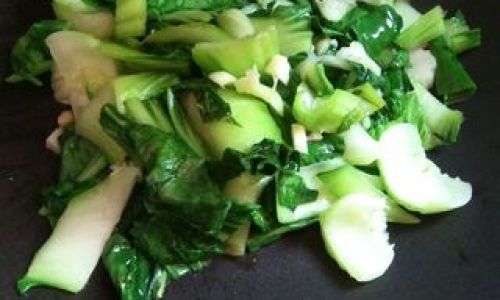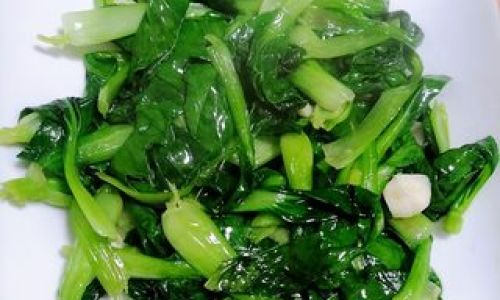Introduction
Stir-fried greens, a cornerstone of Asian cuisine, are celebrated for their vibrant color, crisp texture, and ability to retain nutrients through rapid cooking. This dish, often overlooked in its simplicity, is a canvas for culinary creativity, allowing cooks to balance flavors, textures, and aromas with minimal ingredients. Whether you’re a novice in the kitchen or a seasoned home chef, mastering the technique of stir-frying vegetables can elevate your meals, transforming humble greens into a restaurant-quality side dish or a standalone vegetarian delight. This guide delves into the intricacies of selecting, preparing, and cooking stir-fried greens, ensuring your dish is both visually stunning and bursting with flavor.

Selecting the Right Vegetables
The foundation of a stellar stir-fry lies in choosing fresh, seasonal greens. Leafy vegetables like bok choy, spinach, kale, and Chinese broccoli (gai lan) are ideal candidates due to their tender leaves and sturdy stems, which withstand high heat without wilting into mush. For a twist, experiment with heartier greens like collard greens or mustard greens, adjusting cooking times to accommodate their density.
Key Considerations:
- Freshness: Look for crisp, unblemished leaves with vibrant hues. Avoid wilted or yellowing foliage, as these indicate age or improper storage.
- Variety: Mix textures by combining leafy greens with crunchy additions like bell peppers, carrots, or snow peas. This adds dimension to each bite.
- Quantity: A general rule is 4–6 ounces of greens per person, though this varies by type. Denser greens like kale may require less volume, while spinach cooks down significantly.
Preparing Your Ingredients
Preparation is paramount in stir-frying, as the cooking process happens swiftly. Mise en place—a French culinary term for having all ingredients prepped and ready—is non-negotiable here.
Washing and Drying:
- Rinse greens thoroughly under cold water to remove dirt or pesticides. For leafy vegetables, submerge them in a bowl of water, swish gently, and drain.
- Pat dry with a clean kitchen towel or use a salad spinner. Excess moisture will steam the vegetables instead of stir-frying them, resulting in a soggy texture.
Cutting Techniques:
- Uniformity: Chop vegetables into bite-sized pieces to ensure even cooking. For greens with stems (e.g., bok choy), separate stems from leaves and slice stems diagonally into ½-inch pieces; leaves can be left whole or roughly chopped.
- Thin Slices: Mince garlic, ginger, or shallots finely to infuse the oil with aromatic flavors quickly.
Essential Seasonings and Aromatics
The magic of stir-fried greens lies in the harmony of seasonings. While recipes vary, a few staples elevate the dish:
- Aromatics: Garlic, ginger, and shallots form the flavor base. Sauté them in hot oil until fragrant but not browned.
- Soy Sauce: Adds saltiness and umami. Opt for low-sodium soy sauce if watching salt intake.
- Oyster Sauce: A thick, sweet-savory sauce (vegetarian versions available) that coats the greens with a glossy sheen.
- Sesame Oil: A drizzle at the end imparts nutty richness.
- Optional Enhancements: Chili flakes, rice vinegar, or a pinch of sugar can balance bitterness in greens like kale.
Pro Tip: Pre-measure all seasonings into a small bowl before cooking. This streamlines the process and prevents overcooking.
The Stir-Frying Process: Step by Step
Stir-frying is a dance of heat, timing, and motion. Follow these steps for flawless execution:
Heat the Wok or Skillet:
- Use a carbon-steel wok or a large, heavy-bottomed skillet. Heat over high heat until a drop of water evaporates instantly.
- Add 1–2 tablespoons of oil with a high smoke point (e.g., peanut, canola, or avocado oil). Swirl to coat the pan.
Sauté Aromatics:

- Toss in minced garlic, ginger, or shallots. Stir constantly for 10–15 seconds until golden and aromatic.
Add Vegetables:
- Start with heartier stems or thicker vegetables (e.g., carrot sticks, bell peppers). Stir-fry for 1–2 minutes before adding delicate leaves.
- Introduce leafy greens in batches if necessary, tossing gently to wilt them evenly.
Season and Toss:
- Pour in soy sauce, oyster sauce, or other liquids. Use tongs or a spatula to coat the greens thoroughly.
- For a dry stir-fry, let the liquid evaporate; for a saucier finish, add a splash of broth or water and cover briefly to steam.
Finish with Flair:
- Drizzle sesame oil, sprinkle toasted sesame seeds, or add a squeeze of lime juice just before serving.
Serving Suggestions and Pairings
Stir-fried greens are incredibly versatile. Pair them with:
- Grains: Serve over steamed jasmine rice, quinoa, or cauliflower rice for a complete meal.
- Proteins: Top with grilled tofu, shrimp, or sliced chicken breast for added heft.
- Noodles: Toss with chow mein noodles or soba for a heartier dish.
- Dipping Sauces: Offer a side of chili-garlic sauce or hoisin for dipping.
Tips for Perfect Stir-Fried Greens
- High Heat is Key: Maintain a blazing-hot pan to sear vegetables quickly, preserving their crunch and color.
- Avoid Overcrowding: Cook in batches if needed. Overcrowding the pan steams vegetables instead of stir-frying them.
- Taste and Adjust: Season lightly at first; you can always add more soy sauce or salt later.
- Embrace Imperfection: A few charred edges or unevenly cooked leaves add rustic charm.
Common Mistakes to Avoid
- Using Wet Vegetables: Pat greens dry to prevent steaming.
- Underseasoning: Flavors mellow during cooking, so season boldly.
- Overcooking: Remove from heat while still vibrant and slightly crisp. Residual heat will continue cooking them.
Variations and Creative Twists
- Spicy Kick: Add sliced fresh chilies or a dash of Sriracha during cooking.
- Nutty Crunch: Garnish with crushed peanuts or cashews for texture.
- Citrus Zing: Finish with a spritz of lemon or lime juice to brighten flavors.
- Fermented Flavors: Incorporate a spoonful of kimchi or fermented black beans for depth.
Storage and Reheating
Leftover stir-fried greens can be stored in an airtight container in the refrigerator for up to 3 days. Reheat gently in a skillet over medium heat, adding a splash of water if needed to prevent dryness. Avoid microwaving, as this can make the greens mushy.
Cultural Significance and History
Stir-frying traces its roots to ancient China, where chefs developed high-heat cooking methods to preserve food’s nutritional value and flavor. Today, it’s a symbol of efficiency and balance in many Asian cuisines, embodying the principle of hao chi (delicious) and hao kan (visually appealing).
Conclusion
Stir-fried greens are more than a side dish—they’re a testament to the beauty of simplicity. By mastering the interplay of heat, seasonings, and technique, you can create a dish that’s both nourishing and deeply satisfying. Experiment with vegetables, seasonings, and pairings to make this classic your own. Whether you’re cooking a quick weeknight meal or impressing dinner guests, the art of stir-frying greens is a skill that will serve you—and your taste buds—for a lifetime.
Word Count: 1,620






0 comments